History of the telephone
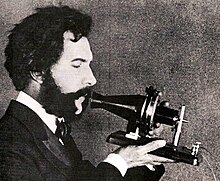
This history of the telephone chronicles the development of the electrical telephone, and includes a brief overview of its predecessors. The first telephone patent was granted to Alexander Graham Bell in 1869.
Mechanical acoustic devices

Before the
Some of the earliest known experiments were conducted by the British physicist and polymath, Robert Hooke, from 1664 to 1685.[1][3] An acoustic string phone made in 1667 has been attributed to him.[4] An early version was also found in use by the Chimu in Peru. The gourd and stretched-hide version resides in the Smithsonian Museum collection and dates back to around the 7th century AD.[5]
For a few years in the late 1800s, acoustic telephones were marketed commercially as a competitor to the electrical telephone. When the Bell telephone patents expired and many new telephone manufacturers began competing, acoustic telephone makers quickly went out of business. Their maximum range was very limited.[2] An example of one such company was the Pulsion Telephone Supply Company created by Lemuel Mellett in Massachusetts, which designed its version in 1888 and deployed it on railroad right-of-ways.
Additionally, speaking tubes have long been common, especially within buildings and aboard ships, and they are still in use today.[6]
Electrical devices
The telephone emerged from the making and successive improvements of the

Centennial Issue of 1976
The electrical telegraph was first commercialized by Sir
Another electrical telegraph was independently developed and patented in the United States in 1837 by Samuel Morse. His assistant, Alfred Vail, developed the Morse code signaling alphabet with Morse. America's first telegraph was sent by Morse on January 6, 1838, across 2 miles (3 km) of wiring.
Invention of the telephone
Credit for the invention of the electric telephone is frequently disputed, and new controversies over the issue have arisen from time to time. Antonio Meucci, Alexander Graham Bell, and Elisha Gray amongst others, have all been credited with the telephone's invention. The early history of the telephone became and still remains a confusing morass of claims and counterclaims, which were not clarified by the huge number of lawsuits filed in order to resolve the patent claims of the many individuals and commercial competitors. The Bell and Edison patents, however, were commercially decisive, because they dominated telephone technology and were upheld by court decisions in the United States.
-
Antonio Meucci, 1854, constructed telephone-like devices.
-
Philipp Reis, 1861, constructed the first telephone, today called the Reis telephone.
-
Alexander Graham Bell was awarded the first U.S. patent for the invention of the telephone in 1876.
-
Elisha Gray, 1876, designed a telephone using a water microphone in Highland Park, Illinois.
-
Tivadar Puskás proposed the telephone switchboard exchange in 1876.
-
Thomas Edison invented the carbon microphone which produced a strong telephone signal.

The modern telephone is the result of the work of many people.[10] Alexander Graham Bell was, however, the first to patent the telephone, as an "apparatus for transmitting vocal or other sounds telegraphically". Bell has most often been credited as the inventor of the first practical telephone. Johann Philipp Reis coined the term "telephon".[11] Models of it were sent abroad, to London, Dublin, Tiflis, and other places. It became a subject for popular lectures, and an article for scientific cabinets. Edison credited him as the "first inventor of the telephone."[12] The
The Elisha Gray and Alexander Bell telephone controversy considers the question of whether Bell and Gray invented the telephone independently and, if not, whether Bell stole the invention from Gray. This controversy is narrower than the broader question of who deserves credit for inventing the telephone, for which there are several claimants.
The Canadian Parliamentary Motion on Alexander Graham Bell article reviews the controversial June 2002 United States House of Representatives resolution recognizing Meucci's contributions 'in' the invention of the telephone (not 'for' the invention of the telephone). The same resolution was not passed in the U.S. Senate, thus labeling the House resolution as "political rhetoric". A subsequent counter-motion was unanimously passed in Canada's Parliament 10 days later which declared Bell its inventor. This webpage examines critical aspects of both the parliamentary motion and the congressional resolution.
Telephone exchange
The main users of the electrical telegraph were post offices, railway stations, the more important governmental centers (ministries), stock exchanges, very few nationally distributed newspapers, the largest internationally important corporations, and wealthy individuals.[14]
Telegraph exchanges worked mainly on a
Prior to the invention of the telephone switchboard, pairs of telephones were connected directly with each other, which was primarily useful for connecting a home to the owner's business (They practically functioned as a primitive
The telephone exchange was an idea of the
In Bell's lecture, during which a three-way telephone connection with
The switchboard built by Coy was, according to one source, constructed of "carriage bolts, handles from teapot lids and bustle wire." According to the company records, all the furnishings of the office, including the switchboard, were worth less than forty dollars. While the switchboard could connect as many as sixty-four customers, only two conversations could be handled simultaneously and six connections had to be made for each call.[21]
The District Telephone Company of New Haven went into operation with only twenty-one subscribers, who paid $1.50 per month. By 21 February 1878, however, when the first telephone directory was published by the company, fifty subscribers were listed. Most of these were businesses and listings such as physicians, the police, and the post office; only eleven residences were listed, four of which were for persons associated with the company.[21]
The New Haven District Telephone Company grew quickly and was reorganized several times in its first years. By 1880, the company had the right from the
Early telephone developments
The following is a brief summary of the history of the development of the telephone:
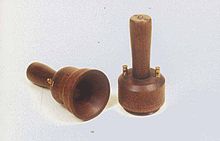
- Early 7th century AD - Chimu culture in Peru invents a string telephoneusing gourds and stretched hide. The original artifact is in the Smithsonian's National Museum of the American Indian storage facility in Suitland, Maryland.
- 1667: string telephonethat conveys sounds over an extended wire by mechanical vibrations. It was to be termed an 'acoustic' or 'mechanical' (non-electrical) telephone.
- 1753: Charles Morrison proposes the idea that electricity can be used to transmit messages, by using different wires for each letter.[22]
- 1844: Innocenzo Manzetti first moots the idea of a "speaking telegraph" (telephone).
- 1854: Charles Bourseul writes a memorandum on the principles of the telephone. (See the article: "Transmission électrique de la parole", L'Illustration, Paris, 26 August 1854.)
- 1854: Antonio Meucci demonstrates an electric voice-operated device in New York; exactly what kind of device he demonstrates is unknown.
- 1861: Philipp Reisconstructs the first speech-transmitting telephone
- 28 December 1871: Antonio Meucci files a patent caveat (No. 3353, a notice of intent to invent, but not a formal patent application) at the U.S. Patent Office for a device he names a "Sound Telegraph".[23]
- 1872: Elisha Gray establishes Western Electric Manufacturing Company.
- 1 July 1875: Bell uses a bi-directional "gallows" telephone that is able to transmit "voicelike sounds", but not clear speech. Both the transmitter and the receiver are identical membrane electromagnet instruments.
- 1875: Thomas Edison experiments with acoustic telegraphy and in November builds an electro-dynamic receiver, but does not exploit it.
- 1875: Hungarian Tivadar Puskás (the inventor of the telephone exchange) arrives in the USA.
- 6 April 1875: Bell's U.S. Patent 161,739 "Transmitters and Receivers for Electric Telegraphs" is granted. This uses multiple vibrating steel reeds in make-break circuits, and the concept of multiplexed frequencies.
- 20 January 1876: Bell signs and notarizes his patent application for the telephone.
- 11 February 1876: Elisha Gray designs a liquid transmitter for use with a telephone, but does not build one.
- 7 March 1876: Bell's U.S. patent No. 174,465 for the telephone is granted.
- 10 March 1876: Bell transmits the sentence: "Mr. Watson, come here! I want to see you!" using a liquid transmitter and an electromagnetic receiver.
- 10 August 1876: Using the telegraph line between Brantford and Paris, Ontario, eight miles (thirteen kilometres) distant, Bell makes a telephone call, said by some to be the "world's first long-distance call".[24]
- 30 January 1877: Bell's U.S. patent No. 186,787 is granted for an electromagnetic telephone using permanent magnets, iron diaphragms, and a call bell.
- 27 April 1877: Edison files for a patent on a carbon (graphite) transmitter. Patent No. 474,230 is granted on 3 May 1892, after a 15-year delay because of litigation. Edison is later granted patent No. 222,390 for a carbon granules transmitter in 1879.
- 6 October 1877: Scientific American publishes the invention from Bell—at that time still without a ringer.
- 25 October 1877: the article in Scientific American is discussed at the Telegraphenamt in Berlin
- 12 November 1877: The first commercial telephone company enters telephone business in Friedrichsberg close to Berlin[25] using the Siemens pipe as ringer and telephone devices built by Siemens.
- 1877: The first experimental Telephone Exchange is established in Boston.
- 1877: First long-distance telephone line
- 1877: Emile Berliner invents the telephone transmitter.
- 14 January 1878: Bell demonstrates the telephone to UK. The queen tries the device and finds it to be "quite extraordinary".[26]
- 26 January 1878: The first permanent telephone connection in the UK is made between two businesses in Manchester
- 28 January 1878: The first commercial US telephone exchange opens in New Haven, Connecticut.
- 15 June 1878: The first commercial toll line enters operation, connecting Springfield and Holyoke, Massachusetts[27]
- 1887: Tivadar Puskás introduces the multiplex switchboard, that has an epochal significance in the further development of telephone exchanges.[28]
- 1915: The first U.S. Thomas Augustus Watsonin San Francisco, California.
- 1927: The first transatlantic phone call is made, from the United States to the United Kingdom.[29]
Early commercial instruments
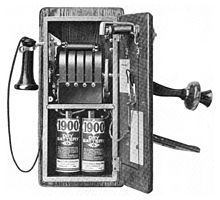
Early telephones were technically diverse. Some of them used liquid transmitters which soon went out of use. Others were dynamic: their diaphragms vibrated a coil of wire in the field of a permanent magnet or vice versa. Such sound-powered telephones survived in small numbers through the 20th century in military and maritime applications where the ability to create its own electrical power was crucial. Most, however, used Edison/Berliner carbon transmitters, which were much louder than the other kinds, even though they required induction coils, actually acting as impedance matching transformers to make it compatible to the line impedance. The Edison patents kept the Bell monopoly viable into the 20th century, by which time telephone networks were more important than the instrument.
Early telephones were locally powered by a dynamic transmitter. One of the jobs of outside plant personnel was to visit each telephone periodically to inspect the battery. During the 20th century, the "common battery" operation came to dominate, and was powered by the "talk battery" from the telephone exchange over the same wires that carried the voice signals. Late in the century, wireless handsets brought a revival of local battery power.
The earliest telephones had only one wire for transmitting and receiving of audio, and used a ground return path. The earliest dynamic telephones also had only one opening for sound, and the user listened and spoke into the same hole. Sometimes the instruments were operated in pairs at each end, making conversation more convenient but also more expensive.

At first, telephones were leased in pairs to the
Signaling began in an appropriately primitive manner. The user alerted the other end, or the exchange operator, by whistling into the transmitter. Exchange operation soon resulted in telephones being equipped with a bell, first operated over a second wire and later with the same wire using a condenser. Telephones connected to the earliest Strowger automatic exchanges had seven wires, one for the knife switch, one for each telegraph key, one for the bell, one for the push button and two for speaking.
Rural and other telephones that were not on a common battery exchange had hand cranked "magneto" generators to produce an alternating current to ring the bells of other telephones on the line and to alert the exchange operator.
In 1877 and 1878, Edison invented and developed the carbon microphone used in all telephones along with the Bell receiver until the 1980s. After protracted patent litigation, a federal court ruled in 1892 that Edison and not Emile Berliner was the inventor of the carbon microphone. The carbon microphone was also used in radio broadcasting and public address work through the 1920s.
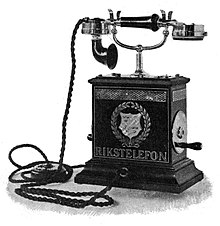
In the 1890s a new smaller style of telephone was introduced, the candlestick telephone, and it was packaged in three parts. The transmitter stood on a stand, known as a "candlestick" for its shape. When not in use, the receiver hung on a hook with a switch in it, known as a "switchhook." Previous telephones required the user to operate a separate switch to connect either the voice or the bell. With the new kind, the user was less likely to leave the phone "off the hook". In phones connected to magneto exchanges, the bell, induction coil, battery, and magneto were in a separate bell box called a "ringer box." In phones connected to common battery exchanges, the ringer box was installed under a desk, or other out of the way place, since it did not need a battery or magneto.
Cradle designs were also used at this time, with a handle with the receiver and transmitter attached, separate from the cradle base that housed the magneto crank and other parts. They were larger than the "candlestick" and more popular.
Disadvantages of single-wire operation, such as
Around 1893, the country leading the world in telephones per 100 persons—known as teledensity—was Sweden with 0.55 in the whole country but 4 in Stockholm (10,000 out of a total of 27,658 subscribers).[30] This compares with 0.4 in the US for that year.[31] Telephone service in Sweden developed through a variety of institutional forms: the International Bell Telephone Company (a U.S. multinational), town and village co-operatives, the General Telephone Company of Stockholm (a Swedish private company), and the Swedish Telegraph Department (part of the Swedish government). Since Stockholm consists of islands, telephone service offered relatively large advantages, but had to use submarine cables extensively. Competition between Bell Telephone and General Telephone, and later between General Telephone and the Swedish Telegraph Dept., was intense.
In 1893, the U.S. was considerably behind Sweden, New Zealand, Switzerland, and Norway in teledensity. The U.S. became the world leadership in teledensity with the rise of many independent telephone companies after the Bell patents expired in 1893 and 1894.
20th-century developments
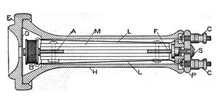


By 1904, over three million phones in the U.S.[32] were connected by manual switchboard exchanges. By 1914, the U.S. was the world leader in telephone density and had more than twice the teledensity of Sweden, New Zealand, Switzerland, and Norway. The relatively good performance of the U.S. occurred despite competing telephone networks not interconnecting.[33] On January 7, 1927, W. S. Gifford, president of the American Telephone & Telegraph Company, called Evelyn P. Murray to test the first commercial telephone line across the Atlantic Ocean.[29]
What turned out to be the most popular and longest-lasting physical style of telephone was introduced in the early 20th century, including Bell's
Starting in the 1930s, the base of the telephone also enclosed its bell and induction coil, obviating the need for a separate ringer box. Power was supplied to each subscriber line by central-office batteries instead of the user's local battery, which required periodic service. For the next half century, the network behind the telephone grew progressively larger and much more efficient, and, after the rotary dial was added, the instrument itself changed little until
The history of mobile phones can be traced back to two-way radios permanently installed in vehicles such as taxicabs, police cruisers, railroad trains, and the like. Later versions such as the so-called transportables or "bag phones" were equipped with a cigarette-lighter plug so that they could also be carried, and thus could be used as either mobile two-way radios or as portable phones by being patched into the telephone network.
In December 1947, Bell Labs engineers Douglas H. Ring and W. Rae Young proposed hexagonal cell transmissions for mobile phones.[35] Philip T. Porter, also of Bell Labs, proposed that the cell towers be at the corners of the hexagons rather than the centers and have directional antennas that would transmit/receive in 3 directions (see picture at right) into 3 adjacent hexagon cells.[36][37] The technology did not exist then and the radio frequencies had not yet been allocated. Cellular technology was undeveloped until the 1960s, when Richard H. Frenkiel and Joel S. Engel of Bell Labs developed the electronics.
Meanwhile, the 1956 inauguration of the TAT-1 cable and later international direct dialing were important steps in putting together the various continental telephone networks into a global network.
On 3 April 1973, Motorola manager Martin Cooper placed a cellular-phone call (in front of reporters) to Dr. Joel S. Engel, head of research at AT&T's Bell Labs. This began the era of the handheld cellular-mobile phone.
Cable-television companies began to use their fast-developing cable networks with ducting under the streets of the United Kingdom in the late 1980s to provide telephony services in association with major telephone companies. One of the early cable operators in the UK,
Digital telephone technology
The rapid development and wide adoption of
MOS SC circuits led to the development of PCM codec-filter chips in the late 1970s.
The British companies
Women's usage in the 20th century

The telephone was instrumental to modernization. It aided in the development of suburbs and the separation of homes and businesses, but also became a reason for the separation between women occupying the private sphere and men in the public sphere.[47] Both historically and currently, women are predominantly responsible for the telephone calls that bridge the public and private sphere, such as calls regarding doctor's appointments and meetings.[48]
21st-century developments
Internet Protocol (IP) telephony, also known as Internet telephony or

IP telephony uses a
Telecommunication of the 21st century has been dominated by the development of the smartphone. This is a combination of a hand-held computer, a cellular phone, a digital camera, and Internet access. One of its features is the touch screen that facilitates the primary interaction for users for most tasks, such as dialing telephone numbers. Some of its software features also include email communication, as well as audio and video playback and capture.
See also
- Carbon microphone
- History of mobile phones
- History of telecommunication
- History of videotelephony
- Private branch exchange
- Push-button telephone
- Telephone exchange
- Timeline of the telephone
- Telegraph in United States history
- Telephone in United States history
- Invention of the telephone
- Bell Telephone Memorial, a major monument dedicated to the invention of the telephone
- Charles Bourseul – claimed inventor of the telephone
- Elisha Gray
- Elisha Gray and Alexander Bell telephone controversy
- Innocenzo Manzetti
- Johann Philipp Reis – claimed inventor of the telephone
- Antonio Meucci – claimed inventor of the telephone
- The Telephone Cases, a series of court decisions in the U.S. on the telephone's invention
- Thomas Edison's carbon telephone transmitter – greatly improved the telephone's sound quality
References
- ^ a b c d McVeigh, Daniel P.
An Early History of the Telephone: 1664-1866: Robert Hooke's Acoustic Experiments and Silent Inventions Archived 24 May 2014 at the Wayback Machine, Columbia University website. Retrieved 15 January 2013. This work in turn cites:
- Richard Waller and edited by R.T. Gunther. "The Postthumous Works of Robert Hooke, M.D., S.R.S. 1705." Reprinted in R.T. Gunther's "Early Science In Oxford", Vol. 6, p. 185, 25
- ^ a b Jacobs, Bill. Acoustic Telephones Archived 27 March 2015 at the Wayback Machine, TelefoonMuseum.com website. Retrieved 15 January 2013. This article in turn cites:
- Kolger, Jon. "Mechanical or String Telephones", ATCA Newsletter, June 1986; and
- "Lancaster, Pennsylvania Agricultural Almanac for the Year 1879: How to Construct a Farmer's Telephone", John Bater's Sons.; and
- "Telephone Experiences of Harry J. Curl as told by him to E. T. Mahood, During the summer of 1933 at Kansas City, Missouri: First Telephone Experience."
- ^ Grigonis, Richard. x +jchdjn$hbdgdveudydcgeenterprise-fixed-communications/articles/47924-telephone-1665.htm A Telephone can 1665?[permanent dead link], TMCNet Technews website, 29 December 2008.
- ^ Giles, Arthur (editor). County Directory of Scotland (for 1901-1904): Twelfth Issue: Telephone (Scottish Post Office Directories), Edinburgh: R. Grant & Son, 1902, p. 28.
- ^ Baldwin, Neil. "There's a 1,200-year-old Phone in the Smithsonian Collections". smithsonianmag.com. Smithsonian Museum. Retrieved 20 August 2022.
- ^ "Voicepipes and Speaking-Tubes". The Museum of Retro-Technology. 15 March 2010. Archived from the original on 10 March 2012. Retrieved 17 October 2012.
- ^ Jones, R. Victor S Archived 11 October 2012 at the Wayback Machine d" Electrochemical Telegraph (1808-10)], Harvard University website. Attributed to "Semaphore to Satellite", International Telecommunication Union, Geneva 1965. Retrieved 2009-05-01
- ISBN 978-1-78326-917-4.
- S2CID 119459958.
- ^ Lewis Coe (1995), "The Telephone and Its Several Inventors"
- ^ "Bell 'did not invent telephone'". December 2003.
- ^ Edison, Thomas A. The Edison Papers, Digital Edition Rutgers University, accessed 26 March 2006. LB020312 TAEM 83:170
- ^ "H.Res.269 - Expressing the sense of the House of Representatives to honor the life and achievements of 19th-century Italian-American inventor Antonio Meucci, and his work in the invention of the telephone. 107th Congress (2001-2002)". U.S. House of Representatives. 11 June 2002. Retrieved 7 February 2014.
- ^ Private Telegraphs, The Sydney Morning Herald, credited to The Times, 19 April 1878, p. 6.
- ISBN 9780201767322.
- ISBN 9781587655227.
- ^ Puskás Tivadar (1844 - 1893) (short biography), Hungarian History website. Retrieved from Archive.org, February 2013.
- ^ "Puskás Tivadar (1844 - 1893)". Mszh.hu. Archived from the original on 8 October 2010. Retrieved 1 July 2012.
- ^ "Puskás, Tivadar". Omikk.bme.hu. Retrieved 1 July 2012.
- ^ "Welcome hunreal.com - BlueHost.com". Hunreal.com. Archived from the original on 16 March 2012. Retrieved 1 July 2012.
- ^ a b c d e f g
Withdrawal of National Historic Landmark Designation: Site of the First Telephone Exchange, New Haven, New Haven County, Connecticut, United States National Park Service, United States Department of the Interior, 13 April 2006. Archived 15 August 2012 at the Wayback Machine
- ^ "History Of The Invention Of Telephone". The Reverse Phone. 9 June 2011. Retrieved 22 April 2012.
- ^ "Antonio Meucci - Questions and Answers". Chezbasilio.org. Retrieved 30 August 2012.
- ^ "Alexander Graham Bell 1847-1922 Inventor of the Bell System". Telecommunications Canada. Retrieved 14 January 2020.
- ^ "Cdrtools (Cdrecord) release information".
- ^ "Alexander Graham Bell demonstrates the newly invented telephone". The Telegraph. 13 January 2017. Archived from the original on 12 January 2022. Retrieved 14 January 2020.
- ^ "Southern New England Telephone Company: The First Fifty Years, 1878-1928". Thomas J. Dodd Research Center. University of Connecticut. Archived from the original on 9 June 2008.
- ^ Francis S. Wagner: Hungarian Contributions to World Civilization – Page 68
- ^ a b "First Transatlantic Telephone Call". Retrieved 22 March 2019.
- ^ Bennett, Alfred Roslin (1895). Telephone Systems of the Continent of Europe. p. 337. Retrieved 14 June 2012.
- ^ "Early U.S. Telephone Industry Data". Retrieved 15 June 2012.
- ^ "AT&T: History: Origins". Corp.att.com. Archived from the original on 20 August 2012. Retrieved 30 August 2012.
- ^ "Leaders in the early spread of telephone service". Purplemotes.net. 21 March 2010.
- ^ "Fig I-102 Type Sidetone Hand Telephone Set Shown with 534Y Subscriber Set". Archived from the original on 16 June 2007. Retrieved 29 May 2007.
- ^ "1947 memo by Douglas H. Ring proposing hexagonal cells" (PDF). Archived from the original (PDF) on 7 February 2012. Retrieved 30 August 2012.
- ^ Farley, Tom; van der Hoek, Mark (1 January 2006). "Cellular Telephone Basics". PrivateLine. Archived from the original on 3 May 2012. Retrieved 22 April 2012.
- ^ interview of Joel S. Engel, page 17 (image 18) Archived 16 June 2007 at the Wayback Machine
- ^ ISBN 9788793609860. Archived from the original(PDF) on 30 September 2021. Retrieved 29 November 2019.
- ISBN 9788793609860. Archived from the original(PDF) on 30 September 2021. Retrieved 29 November 2019.
- ^ ISBN 9781420041163.
- S2CID 27580722.
- S2CID 25112828.
- ^ Wireless World: 383. August 1970.
- ^ ISSN 0262-4079.
- U.S. Government Printing Office. 1974. p. 23.
- ^ Gust, Victor; Huizinga, Donald; Paas, Terrance (January 1976). "Call anywhere at the touch of a button" (PDF). Bell Laboratories Record. 54: 3–8.[permanent dead link]
- ISBN 0710206798. Retrieved 9 February 2014.
- ISBN 978-0710206794.
- This article includes text from Withdrawal of National Historic Landmark Designation: Site of the First Telephone Exchange, New Haven, New Haven County, Connecticut, by the United States National Park Service, a work in the public domain.
Further reading
- Baker, Burton H. (2000), The Gray Matter: The Forgotten Story of the Telephone, Telepress, St. Joseph, MI, 2000. ISBN 0-615-11329-X
- Bruce, Robert V. (1990), Alexander Graham Bell and the Conquest of Solitude, Cornell University Press, Ithaca, 1990.
- Casson, Herbert N. (March 1910). "The Birth Of The Telephone: Its Invention Not An Accident But The Working Out Of A Scientific Theory". The World's Work: A History of Our Time. XIX: 12669–12683. Retrieved 10 July 2009.
- Casson, Herbert N. (May 1910). "The Future Of The Telephone: The Dawn Of A New Era Of Expansion". The World's Work: A History of Our Time. XX: 12903–12918. Retrieved 10 July 2009.
- Coe, Lewis (1995), The Telephone and Its Several Inventors: A History, McFarland, North Carolina, 1995. ISBN 0-7864-0138-9
- Evenson, A. Edward (2000), The Telephone Patent Conspiracy of 1876: The Elisha Gray - Alexander Bell Controversy, McFarland, North Carolina, 2000. ISBN 0-7864-0883-9
- Huurdeman, Anton A. (2003), The Worldwide History of Telecommunications, IEEE Press and J. Wiley & Sons, 2003. ISBN 0-471-20505-2
- John, Richard R (2010), Network Nation: Inventing American Telecommunications, Harvard University Press, 2010; traces the evolution of the country's telegraph and telephone networks.
- Josephson, Matthew (1992), Edison: A Biography, Wiley, 1992. ISBN 0-471-54806-5
- Wheen, Andrew (2011), DOT-DASH TO DOT.COM: How Modern Telecommunications Evolved from the Telegraph to the Internet (Springer, 2011). ISBN 978-1-4419-6759-6
- Martin, Michèle (1988). "Feminisation of the Labour Process in the Communication Industry: The Case of the Telephone Operators, 1876-1904". Labour / Le Travail. 22: 139. doi:10.2307/25143030.
External links
- Silvanus P. Thompson - Philipp Reis: Inventor of the Telephone A Biographical Sketch, London, 1883
- Kempe, Harry Robert; Garcke, Emile (1911). . Encyclopædia Britannica. Vol. 26 (11th ed.). pp. 547–557.
- "Alexander Graham Bell (1847-1922)". Scottish Science Hall of Fame. National Library of Scotland. Retrieved 31 January 2014.
- History of the Telephone in Washington, DC - Ghosts of DC blog
- Jay L. Zagorsky (14 March 2019). "Rise and fall of the landline: 143 years of telephones becoming more accessible – and smart". The Conversation. Retrieved 3 April 2022.






